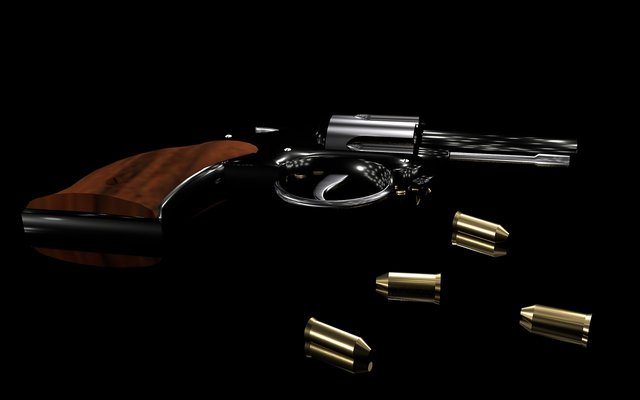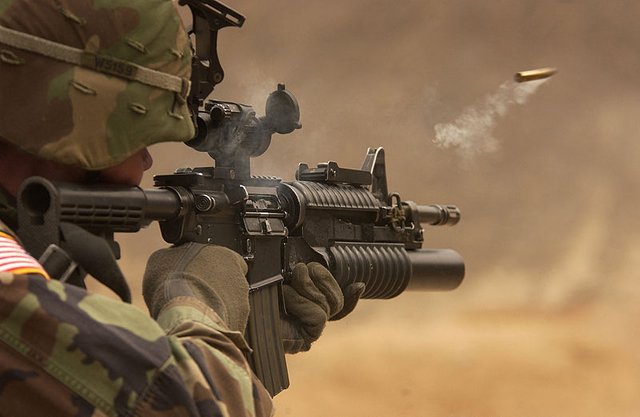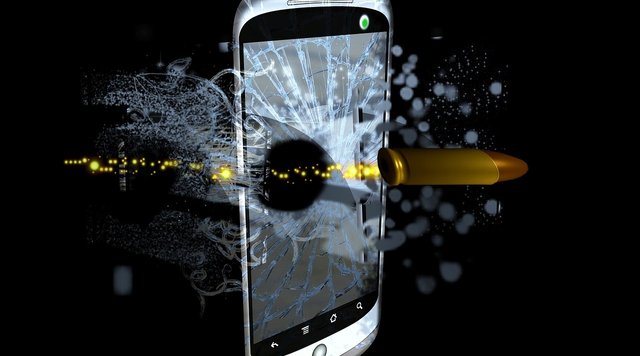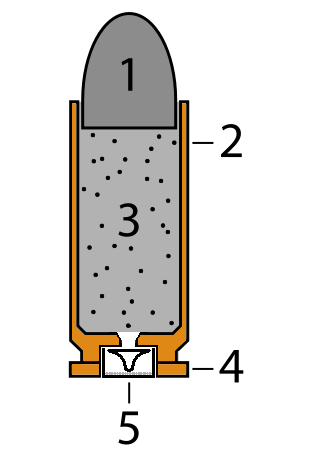Understanding the working mechanisms of bullets and missiles
The story of virtually every continent, every country and even tribes cannot be complete without the mention of chemical explosives, the main power behind guns, bombs and missiles. It is not debatable that no single invention has shaped the history of mankind in the last 1000 years as much as chemical explosives. Before the invention of gunpowder, people relied on crude weapons like swords and spears to fight their enemies in times of conflict.

[Source: Pixabay. CC0 licensed]
Today, everything has changed. You no longer need to come face-to-face with your enemies in order to fight them. You can rain bombs on your enemies from planes; you can use sniper guns to take down your enemies from afar; you can even send intercontinental missiles from one continent to another. The improved effectiveness is the result of positive innovation following years of scientific researches and dedication. As sophisticated as today's weapons are, the basic science and technology behind them is still pretty much the same as it was 1000 years ago. Let's take a closer look at how they work in this article.
Anatomy of a bullet cartridge
Missiles and bullets come in different sizes and shapes. A single intercontinental ballistic missile can be as big as three times the length of a station wagon. But irrespective of their sizes, they all work in pretty much the same way as a bullet of a small handgun, meaning that they are all similar in anatomy and working mechanisms. Let's us find out what's inside a typical bullet cartridge by examining its anatomy.
[Image showing components of a cartridge. Source: wikimedia commons. Author: Quadrell. Public domain licensed]
More often than not, the term "bullet" is incorrectly used to mean a cartridge round. It should be noted that a cartridge is the correct name for a single round of ammunition. Bullet is never a cartridge but just a component of oneref. A typical round of ammunition cartridge is made of four major components namely:
The bullet (i.e the projectile): This is the metal cylinder that is mounted at the apex end of a cartridge. It is the part that is shot out and hit objects at high speed. Bullets are normally tapered at one end for easy movement through air molecules, and also to enable them penetrate and cause harm to their targets.
The case: This is the part that holds everything that make up a cartridge. The primer is fitted into a small pocket found at the base of the case while the powder is contained in its inside chamber and the bullet seated at the opposite open end of the cartridgeref. In a semi-automatic rifle, the case is automatically flung out or dropped after the rifle has been fired.
The propellant: This provides the energy that is used to launch the projectile. It is known as the bullet's 'main engine' because it powers the bullet down the gun and through the air to hit the target.
The primer or repercussion cap: The job of the primer is to ignite the propellant. It works like the fuse of a firework — a small fire that starts a more aggressive oneref.
The science of firing a bullet
Cartridges are made to be relatively safe until they are triggered to fire. On pulling the trigger of a gun, a spring mechanism prompts a metal firing pin to hammer the back end of the cartridge. This ignites a small explosive component of the primer which in turn ignites the propellant, the main energy source of the process. A lot of gas is generated very quickly as the propellant constituents burn, causing a high pressure buildup within the propellant chamber. This sudden high pressure buildup coming from the rapid generation of lots of gas causes the bullet to break free from the end of the cartridge and forces it down the barrel at very high speed of (about 300m/s for a handgun). It should be noted that of all the components of a typical cartridge, only the bullet is ejected out of the barrel at high speed. The rest stays back and are either removed automatically or manually to make way for the next cartridge to load and fire too.

[Source: wikimedia commons. Author: Staff Sgt. Suzanne. Public domain licensed]
The propellant constituents are not designed to explode suddenly all at once as this could kill the person firing it. They are, instead, designed to burn gradually in what's known as conflagration process during which the cartridge are made to move smoothly down the gun. However, as the bullet moves down the barrel, the propellants burn quickly in order to give it maximum possible power by the time it emerges from the barrel end. Once the cartridge emerges from the barrel, the whole gun recoils in agreement with the Newton's law of motion called action and reaction.
When the gas from the explosion shoots the bullet forwards with force, the whole gun jolts backwards with an equal force in the opposite direction. || Source
A bullet is fired by the explosion occurring within the confined space of the gun barrel. And so as the bullet is ejected out at high speed, the pressure of the explosion which has already builtup is then released. This explains the bang sound a gun makes when fired. It is somewhat synonymous to uncorking a bottle of wine (but at a much higher speed and pressure).
Understanding why bullets do damage to their targets
Every moving object, according to the learned Newton, has momentum which also happens to be the product of its mass and velocity. The momentum of a moving object is proportional to its weight (mass) and velocity (speed). This is to say, in other words, that the faster an object moves and the heavier it is, the more momentum it would have. For example, a heavy truck that is moving slowly has lots of momentum because of its weight. The same is also true for a tiny bullet because it moves so fast. A bullets that's moving so fast possesses a lot of kinetic energy which it got from the burnt chemicals of the propellant. By kinetic energy equation, kinetic energy of an object is directly proportional to the square of the object's velocity. Hence, if the object travels twice as fast, it would possess four times the energy.

[Source: Pixabay. CC0 licensed]
By law of conservation of energy, energy can be transferred from one form into another. Hence, bullets do damage by transferring their kinetic energy to the things they hit. Taking into account that Force is also defined as the rate at which an object's momentum changes. An object that loses its momentum in a faster way, would produce greater force on impact. So a fast moving bullet that comes to rest in a split of a second would most likely produce the same amount of force as a slow moving heavy truck that comes to rest in about 10 seconds. If these scenarios are to be true, you can then imagine the impact a truck would have on hitting an object, that's the same amount of impact a fast moving bullet would make on its target. This explains why bullets sometimes swept its human victims off their feet.
In conclusion, bullet cartridges and missiles of all sizes and shapes work on a similar principle. We don't have to get confused by their huge sizes or small sizes. Technically, all of them are the same. And by virtue of this article, we now know the science behind triggering a gun, why it makes such a deafening sound, why the shooter is always jolted back once the bullets emerge from the barrel and why bullets do so much damage to their targets. The mystery behind all of these has been demystified. Thanks for reading.
References for further reading*
- Bullets
- Ballistics
- Anatomy of ammo
- How bullets work
- Firearm
- Bullets and missiles
- It's made of science: gun and bullet ballistics
- The simple physics that make some bullets deadlier than others
Yours truly,
@eurogee
Do You Blog About Science, Technology, Engineering, and Mathematics? If Yes, Patiently Read The Below Info


Join Euronation Community on Telegram and whatsapp through the below links to socialize with larger steemit community:

No Witnesses = No Steem Blockchain; If You Truly Love Here, Vote For Witnesses NOW!
Click This Link To Vote Now



Thanks for this lovely piece of information concerning the working principle of ammos. I have a couple of comments;
Is the propellant also another name for gun powder?
You said bullets are usually tapered at one end. This might not be in all cases depending on the type of gun. SOme cartridge have several small, round metal balls at the extreme end of the cartridge which usually spread out at high speed during shooting.
Also, I have witnessed a situation during which locals use decapitated nails and gun powder as an improvisation for cartridge/ammo. It's usually deadly, one can actually see the projection of the nail (usually red hot when shot) at night. On which principle is this improvisation made?
Talking about the ballistic missiles, what kind of mechanism is used such that the weapon becomes extremely accurate in its target?
Hey @hadji
Here's a tip for your valuable feedback! @Utopian-io loves and incentivises informative comments.
Contributing on Utopian
Learn how to contribute on our website.
Want to chat? Join us on Discord https://discord.gg/h52nFrV.
Vote for Utopian Witness!
Thanks for reading first and foremost. Now to your questions..
Yes sir.
That's why I used the term 'usually' as against 'always'
Same sir.
I hope missile guidance should answer your question.
Regards
@eurogee
You did an expository piece on the concept of bullets. - Well, that's why; if you throw a bullet at someone, it wouldn't hurt the person, but if you fire the same bullet from the barrel of a gun, it would be lethal.
Nice piece man
Exactly sir. Thanks
Nice expository post on the working mechanism of guns and missiles
However, the threat posed by them cannot be over emphasized. Their ability to destroy a work of a lifetime in seconds underlines weight of the threat they pose
Thanks you for reading
In addition, although the principle behind firing a bullet is the same as that of missile irrespective of their size, missile are guided and self-propelled in nature. Within its system, comes other additional features like target system, guidance system and also an explosive warhead (this provides its intended destructive power). And so to say the bigger the missile, the more its destructive power. Nicely written sir
Thanks for the added info.
Congratulations, your post had been chosen by curators of eSteem Encouragement program. Feel free to join and reach us via Discord channel if you have any questions or would like to contribute.
Thank you for using eSteem
This post has been voted on by the steemstem curation team and voting trail.
There is more to SteemSTEM than just writing posts, check here for some more tips on being a community member. You can also join our discord here to get to know the rest of the community!
Hi @eurogee!
Your post was upvoted by utopian.io in cooperation with steemstem - supporting knowledge, innovation and technological advancement on the Steem Blockchain.
Contribute to Open Source with utopian.io
Learn how to contribute on our website and join the new open source economy.
Want to chat? Join the Utopian Community on Discord https://discord.gg/h52nFrV